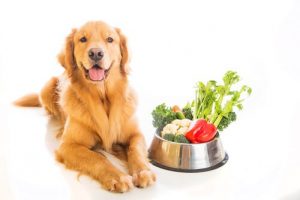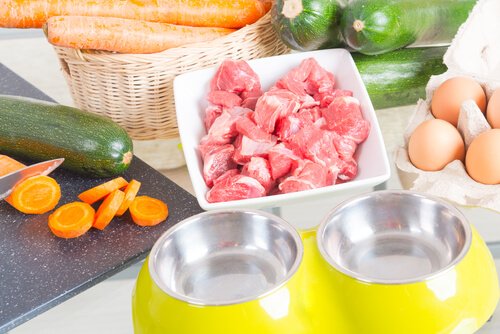When to Have Your Do Switch to a Soft Food Diet


Written and verified by the lawyer Francisco María García
There are many dogs that throw up or get diarrhea after eating too much or ingesting something toxic. Kibble is usually unappetizing and hard for dogs to digest when they’re having these issues. That’s why a soft food diet is the best way to avoid malnutrition and dehydration.
As always, talk to your vet before you making any changes to your dog’s diet. They can analyze your dog and figure out the source of the problem. However, read this article to learn how and when you should give your dog a soft food diet.
When do you need to have your dog switch to a soft food diet?
The main goal is to feed your dog easy-to-digest food that gives him all the nutrients he needs and to keep him hydrated. It’s a very good diet if your dog is having often diarrhea or vomiting.
It can also be helpful in any of the following situations:
- Loss of appetite.
- A transition period between factory food (kibble) to a natural, homemade diet (BARF).
- Digestive problems.
- Recovering from surgery.
- Malnutrition or extreme frailty.
- During cancer treatment.
A soft food diet for malnutrition or frailty should be high in calories to make up for nutritional deficiencies. It’s best to give your dog a lot of easily digestible proteins and good fats, such as omega 3-6-9 fatty acids.
You can add carbohydrates, but only in small amounts so they don’t cause gas-related or digestive problems.
How do you keep a soft food diet nutritious?
A homemade, nutritious, natural soft food diet should have 80% animal proteins and 20% fruits or vegetables. The protein should come from white low-fat meats such as chicken, rabbit, fish, turkey, etc.

The fruits and vegetables need to be easy to digest and high in fiber, such as apples, squash, potatoes, carrots, strawberries, and peaches. It’s best to boil them and use the same water when you’re making the rest of your dog’s food.
Avoid leafy greens and citruses, they can damage a dog’s digestive tract.
Dogs are naturally predisposed to eat raw meat and all the enzymes that come from it. However, it can be good to cook any meat before feeding it to your dog to prevent salmonella or other similar diseases.
In general, you should avoid using spices or condiments. However, there are some exceptions, like turmeric, that are good for a dog’s digestive and immune systems. Even with an adult dog, never give him more than 60 milligrams of turmeric, and no more than 2-3 times a week.
How do you serve a soft food diet?
A dog with diarrhea, vomiting, or loss of appetite will be extremely hungry and probably thirsty too. It’s very important to make sure he doesn’t eat too much, so start by giving him small portions. You can increase the portion size as time goes on.
How much and how many times a day he eats is something your vet needs to determine once he/she has figured out what’s wrong with your dog. A dog with diarrhea should normally eat about 4-5 times a day on a soft food diet.

The reason why you should give your dog small amounts of food is to stimulate his digestive tract without causing it too much strain. In other words, you’re slowly getting your dog back to his normal state.
Continue feeding your dog the soft food diet until his diarrhea or vomiting goes away. An adult dog should normally get better within 2-3 days, but that can vary depending on his overall health. Puppies and older dogs need special attention to make sure they get back to normal.
Probiotics in a soft food diet
The issue with diarrhea and digestive problems is that they affect your dog’s gut bacteria. Besides making it harder to digest food and absorb nutrients, they also weakens your dog’s immune system.
Probiotic foods are a great way to help restore your dog’s gut bacteria. The best natural sources of these are yogurt and kefir, but never more than a spoonful a day.
They’re non-digestible microorganisms that act as food for the good bacteria in the digestive tract. That’s why they make such a good supplement to your dog’s diet when it’s having these kinds of problems.
Whatever the issue is, it’s always better safe than sorry.So talk to your vet before you make any changes to your dog’s diet.
There are many dogs that throw up or get diarrhea after eating too much or ingesting something toxic. Kibble is usually unappetizing and hard for dogs to digest when they’re having these issues. That’s why a soft food diet is the best way to avoid malnutrition and dehydration.
As always, talk to your vet before you making any changes to your dog’s diet. They can analyze your dog and figure out the source of the problem. However, read this article to learn how and when you should give your dog a soft food diet.
When do you need to have your dog switch to a soft food diet?
The main goal is to feed your dog easy-to-digest food that gives him all the nutrients he needs and to keep him hydrated. It’s a very good diet if your dog is having often diarrhea or vomiting.
It can also be helpful in any of the following situations:
- Loss of appetite.
- A transition period between factory food (kibble) to a natural, homemade diet (BARF).
- Digestive problems.
- Recovering from surgery.
- Malnutrition or extreme frailty.
- During cancer treatment.
A soft food diet for malnutrition or frailty should be high in calories to make up for nutritional deficiencies. It’s best to give your dog a lot of easily digestible proteins and good fats, such as omega 3-6-9 fatty acids.
You can add carbohydrates, but only in small amounts so they don’t cause gas-related or digestive problems.
How do you keep a soft food diet nutritious?
A homemade, nutritious, natural soft food diet should have 80% animal proteins and 20% fruits or vegetables. The protein should come from white low-fat meats such as chicken, rabbit, fish, turkey, etc.

The fruits and vegetables need to be easy to digest and high in fiber, such as apples, squash, potatoes, carrots, strawberries, and peaches. It’s best to boil them and use the same water when you’re making the rest of your dog’s food.
Avoid leafy greens and citruses, they can damage a dog’s digestive tract.
Dogs are naturally predisposed to eat raw meat and all the enzymes that come from it. However, it can be good to cook any meat before feeding it to your dog to prevent salmonella or other similar diseases.
In general, you should avoid using spices or condiments. However, there are some exceptions, like turmeric, that are good for a dog’s digestive and immune systems. Even with an adult dog, never give him more than 60 milligrams of turmeric, and no more than 2-3 times a week.
How do you serve a soft food diet?
A dog with diarrhea, vomiting, or loss of appetite will be extremely hungry and probably thirsty too. It’s very important to make sure he doesn’t eat too much, so start by giving him small portions. You can increase the portion size as time goes on.
How much and how many times a day he eats is something your vet needs to determine once he/she has figured out what’s wrong with your dog. A dog with diarrhea should normally eat about 4-5 times a day on a soft food diet.

The reason why you should give your dog small amounts of food is to stimulate his digestive tract without causing it too much strain. In other words, you’re slowly getting your dog back to his normal state.
Continue feeding your dog the soft food diet until his diarrhea or vomiting goes away. An adult dog should normally get better within 2-3 days, but that can vary depending on his overall health. Puppies and older dogs need special attention to make sure they get back to normal.
Probiotics in a soft food diet
The issue with diarrhea and digestive problems is that they affect your dog’s gut bacteria. Besides making it harder to digest food and absorb nutrients, they also weakens your dog’s immune system.
Probiotic foods are a great way to help restore your dog’s gut bacteria. The best natural sources of these are yogurt and kefir, but never more than a spoonful a day.
They’re non-digestible microorganisms that act as food for the good bacteria in the digestive tract. That’s why they make such a good supplement to your dog’s diet when it’s having these kinds of problems.
Whatever the issue is, it’s always better safe than sorry.So talk to your vet before you make any changes to your dog’s diet.
This text is provided for informational purposes only and does not replace consultation with a professional. If in doubt, consult your specialist.







